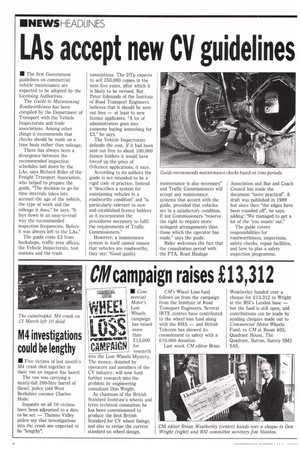Us accept new CV guidelines
Page 8

If you've noticed an error in this article please click here to report it so we can fix it.
• The first Government guidelines on commercial vehicle maintenance are expected to be adopted by the Licensing Authorities.
The Guide to Maintaining Roadworthiness has been compiled by the Department of Transport with the Vehicle Inspectorate and trade associations. Among other things it recommends that checks should be made on a time basis rather than mileage.
There has always been a divergence between the recommended inspection schedules laid down by the LAs, says Richard Rider of the Freight Transport Association, who helped to prepare the guide. "The decision to go for time intervals takes into account the age of the vehicle, the type of work and the mileage it does," he says. "It lays down in an easy-to-read way the recommended inspection frequencies. Before it was always left to the LAS."
The guide costs £3 from bookshops, traffic area offices, the Vehicle Inspectorate, test stations and the trade associations. The Dip expects to sell 250,000 copies in the next five years, after which it is likely to be revised. But Peter Edmunds of the Institute of Road Transport Engineers believes that it should be sent out free — at least to new licence applicants. "A lot of administration goes into someone buying something for £3," he says.
The Vehicle Inspectorate defends the cost. If it had been sent out free to about 100,000 licence holders it would have forced up the price of 0-licence applications, it says.
According to its authors the guide is not intended to be a rigid code of practice. Instead it "describes a system for maintaining vehicles in a roadworthy condition" and "is particularly relevant to new and established licence holders as it incorporates the procedures necessary to fulfil the requirements of Traffic Commissioners."
However, a maintenance system in itself cannot ensure that vehicles are roadworthy, they say: "Good quality maintenance is also necessary' and Traffic Commissioners will accept any maintenance systems that accord with the guide, provided that vehicles are in a satisfactory condition. If not Commissioners "reserve the right to require more stringent arrangements than those which the operator has made," says the guide.
Rider welcomes the fact that the consultation period with the FTA, Road Haulage Association and Bus and Coach Council has made the document "more practical". A draft was published in 1989 but since then "the edges have been rounded off', he says, adding: "We managed to get a lot of the you musts' out."
The guide covers responsibilities for roadworthiness, inspections, safety checks, repair facilities, and how to plan a safety inspection programme.












































































































